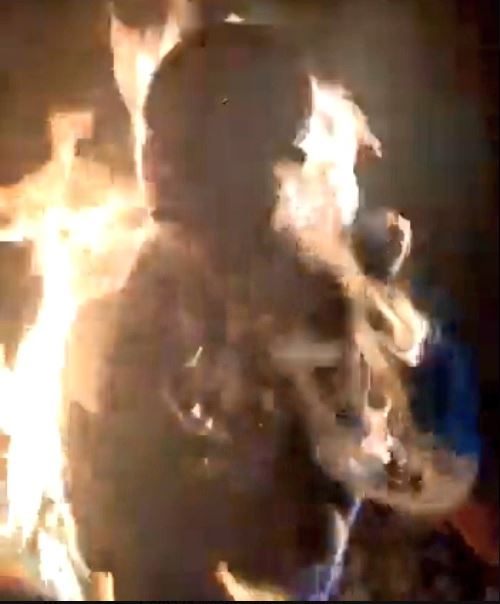
It is one of the most disturbing images on the internet, like something out of an especially horror film, except that it is very much real. If anything encapsulates the cause of the conflict, in the Democratic Republic of Congo (DRC), it is that image.
A dark figure of a man, sits calmly, immobile, as flames lap all over him. It is as though a black marble statue has been dowsed in petrol and set alight.
The figure’s expression is a combination of surprise and horror, as though he can barely believe what is happening to him. The figure is no statue, it is flesh and blood, being consumed by flames. He is being burned alive. He does not register what must surely be unimaginable terror and pain. Has his brain retreated to some realm, to protect him from having to feel?
His eerie, almost meditative calm, is in stark contrast to the excitable noise of the crowd around him. His murderers. As though infuriated by his apparent respite from the agony they wish, and wrought upon him, they are jeering, taunting him. He and they occupy different realms now, and yet they are irrevocably connected.
We do not know their names, and would rather not know their faces, but we will forever know them by his agonising death. Whatever death awaits all of them in the fullness of time, even it will not erase their crime. Time itself will remember them, as his torturers and murderers.
But why, why do such an accursed thing? What minds, hearts, can morph into being at one with such a crime, although even referring to it as a crime, seems a gross understatement, to quotidian a word, to contain what is perpetrated.
The man was in his youth, and his name was Jeremie Renzaho Habimana. He met his death in Goma, one of many people fleeing conflict from his native Masisi.
On a fateful December evening, last year, Habimana was chanced upon by a gang of men, similar to him in age. They were what are now referred to as “Wazalendo”, members of armed groups who exist to prey on their compatriots, especially Kinyarwanda speaking Congolese.
Looting, murder, rape, are a way of life for these groups, which numbered over 130. Since last year, when the government of President Felix Tshisekedi, declared that they were no longer negative forces, but “patriots”, they have been known as “Wazalendo.” They now don the uniform of the national army, FARDC (Armed Forces of the Democratic Republic of Congo), and are routinely armed by the government.
They continue to murder, rape and pillage, but now they do so it as a patriotic duty, against primarily, but not exclusively, Kinyarwanda speaking Congolese.
“You don’t know when they will smash your door in the dead of night” says one Goma residenet who declined to be named, “if you are lucky, they will take what they want and leave you alive. Every morning we God for making it through the night.”
It is these “patriots”, into whom Habimana fell, as he negotiated what to him, were unfamiliar streeets of Goma. He was set upon, battered to within an inch of his soon to be ended life, doused in fuel and set alight. His crime? He was Kinyarwanda-speaking Congolese, a Tutsi.
Habimana was not the first, nor sadly, would he be the last to meet such a gruesome death. Not long after his death, another young man, Gustave Lumoo, was murdered, reportedly by the same group of “Wazalendo.” His crime too, was that he was Tutsi, except that he was not, he was simply mistaken for being Tutsi, which in Congo, carries a death sentence.
Such depravity has become the norm in the DRC. Most recently, this month, a member of FARDC (Armed Forces of the Democratic Republic of Congo), Captain Patrick Rukatura Gisore, was burned and then cannibalised. Gisore was handed over to the “Wazalendo” by his colleagues, who reviled him for “looking Tutsi.” The cannibalism too has become accepted, with the perpetrators filming themselves, defiantly challenging any viewer who recoils from their abomination.
If there is any international recognition of these crimes, as there has been on one occasion, the government feigns an arrest, and quietly releases the the culprits later.
Despite the many members of international media gathered in Goma, these murders have gone largely unreported, and so, we have had even the ostentatious pantomime of going through the motions of making arrests, or carrying out “investigations.”
The genocide has been overused of late, the murders of Kinyarwanda-speaking Congolese however cannot be described as anything other than genocidal murders. As in any genocide, it is the state that is the architect of the crimes.

